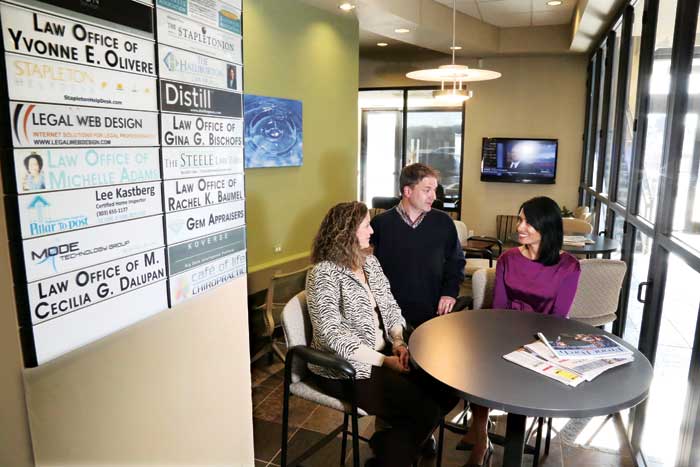
Members of Conservatory Green Professionals at Home gather at Starbucks in Northfield to enjoy the “water cooler moments” they miss out on by working at home. Left to right: Dan Russell, Chris Englert, Deanna and James Landers, and Terry Manns.
For many workers, there’s no place like home—professionals in many fields are choosing to work at home, finding it provides family flexibility and saves both time and money.
“Working at home gives us great flexibility to take care of our three kids, and it allows us to do the work we like,” said architect Heather Calme, one half of the Calme Design Group with her husband, Kevin.
Terry Manns, sales manager for a software company, said he works well in the quiet atmosphere at home. He also likes the flexibility to set his own hours. “I’m able to work without interruptions during the day,” said Mann, whose wife works downtown. “I like that I can work any time.”
Deanna Landers appreciates the time she gains by not driving to work. “It’s quite time-saving with a commute of nothing,” said Landers, a project manager for IBM who supervises 15 field employees. “I want to be doing something at all times.”
“My home office saves on overhead,” said Yvonne Olivere, an attorney who specializes in estate planning and a mother of three. She rents space for meetings at SmartSpace in Stapleton. “I probably pay a quarter of what I’d pay for my own office space,” she said.
Working at home has its challenges, however. For those on the extroverted side, the isolation can be difficult.
“It can get lonely,” said Olivere. “I need face time; I cannot be alone for too long. I need to be around people and feel their energy.”
Mann said: “I’m envious of my wife because she has water cooler time. I don’t get to hear the rumors—who got hired or fired. I need to make a call to find out what’s going on in the organization. I miss the social aspects too.”
At-home workers find the interaction they need at neighborhood groups of home-based professionals. The Calmes and Olivere attend the Stapleton Home Business Network; Landers and Mann attend the Professionals at Home group, newly formed in their Conservatory Green neighborhood.
Both groups meet once a month and are comprised equally of men and women. The Stapleton group has up to 15 attendees each month, while the Conservatory Green group has had three to ten members at each meeting so far.
“There’s a good mix of fields represented,” said Olivere. “You meet people who work for high-tech companies, entrepreneurs, insurance salespeople, realtors, consultants, graphic artists and corporate marketers.”
Both groups offer opportunities for members to share their knowledge about aspects of running a business. Topics include bookkeeping, marketing and management, as well as new productivity tools and travel tips.

A group meets at SmartSpace in Stapleton, which provides office space for small and home businesses that don’t need full offices. Left to right: Architecture and design construction management owners Heather and Kevin Calme and lawyer Yvonne Olivere.
“The group helps us stay connected to the outside world,” said Olivere.
Groups also offer opportunities to socialize with new people, which is particularly important for new Conservatory Green residents. Chris Englert formed the neighborhood’s group to discuss working at home, but also to get residents together and forming friendships.
“The guys in the group go out together for beers,” Manns said.
Other groups, including “mommy” groups and sports teams, help at-home workers stay connected. The professionals also find creative ways to get “face time.”
“I have a mentor I talk to several times a week and I bounce ideas off her,” Olivere said. “I mentor other people too, and I meet colleagues for breakfast. Other people have the same need to get out of the office, so we meet at Starbucks and work across from each other. Or someone comes to my house and works on their own thing at my kitchen table.”
Other challenges of working at home include setting boundaries around work times and handling family demands. “Working at home, you can work at any time, but that’s a double-edged sword,” said Manns. “Once the family gets home, it’s family time. I just don’t go into my office, but it’s hard sometimes not to go in there.”
Olivere said: “Piles of laundry calling my name and the dog barking can make it a challenge to focus on work during the day. At night after the kids are in bed, I see a stack of folders of work in my office. So I have to keep myself in check and set boundaries. I don’t go into my office after 6pm and I don’t check email. But shutting it off is tough.”
“Work-life balance is easy because I have a 6-year-old son,” said Landers. “When I was in my 20s and 30s I was defined by work. But now that balance is essential: When my son is at school, I work. I put in the hours I need to have both work and family. I can work at night, but only if I miss hours during the day.”
Meeting the needs of their children challenges work-at-home parents.
“Some people can’t handle working at home because they can’t close the door because of the kids,” said Landers. “It helps to have a good nanny, daycare, a friend’s house or day camp. You need to set boundaries with your kids. Work time is not your time with them; they need to learn this isn’t their time. I make that clear and set expectations.”
Olivere said: “If I have a sick child and a conference call, it’s a conundrum. Kids feel you are ignoring them if you’re home and telling them you’re busy all the time. I want my attention on them when we’re all home. I tried a nanny but the kids know you are there and they still want you. It’s tough to get work done. So by trial and error I’ve decided to send them to camps this summer, to have them out of the house. I thought the nanny would be great because it saves money, but it didn’t work.”
Calme and her husband, Kevin, are able to share childcare responsibilities because they both office at home. “We tag team to free up each other’s time,” Calme said. “We also have a grandma living in Stapleton, so that helps when we both have to be gone. Usually we don’t need daycare.”
Landers, Manns, Calme and Olivere offered tips for successful at-home work:
Landers: “Take care of yourself and don’t skip lunch.”
Manns: “Be available for family time,” and “Get up from your desk and walk around periodically.”
Olivere: “Create a schedule and set your work hours,” and “Set boundaries around how often you go out to lunch and coffee. Too much means you’re not getting your work done.”
Calme: “Stay up with your industry. It’s easy not to, but you need to stay competitive. Don’t get stuck where you are; be innovative.”



0 Comments